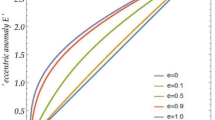Abstract
This paper presents a non-iterative approach to solve Kepler’s Equation, M = E − e sin E, based on non-rational cubic and rational quadratic Bézier curves. Optimal control point coordinates are first shown to be linear with respect to orbit eccentricity for any eccentric anomaly range. This property yields the development of a piecewise (e.g., 3, 4) solving technique providing accuracies better than 10−13 degree for orbit eccentricity e ≤ 0.99. The proposed method does not require large pre-computed discretization data, but instead solves a cubic/quadratic algebraic equation and uses a single final Halley iteration in only a few lines of code. The method still provides accuracies better than 10−5 degree for the near parabolic worst case (e = 0.9999) with very small mean anomalies (M < 0.0517 deg). The complexity of the proposed algorithm is constant, independent of the parameters e and M. This makes the method suitable for extensive orbit propagations.
Similar content being viewed by others
References
Battin R.H. (1987). An Introduction to the Mathematics and Methods of Astrodynamics. AIAA Education Series, New York
Bézier P.E. (1968). Procédé de Définition Numérique des Courbes et Surfâces non Mathématiques. Automatisme XIII(5): 189–196
Colwell P. (1993). Solving Kepler’s Equation over Three Centuries. Willmann-Bell, Richmond, VA
Farin G.: A history of curves and surfaces in CAGD. In: Farin G., Kim M.S., Hoschek J. (eds.), Handbook of CAGD. Elsevier (2002)
Feinstein S.A., McLaughlin C.A. (2006). Dynamic discretization method for solving Kepler’s equation. Celest. Mech. Dyn. Astron. 96: 49–62
Fukushima T. (1997). A method solving Kepler’s Equation without transcendental function evaluations. Celest. Mech. Dyn. Astron. 66: 309–319
Markley F.L. (1996). Kepler equation solver. Celest. Mech. Dyn. Astron. 63: 101–111
Nijenhuis A. (1991). Solving Kepler’s equation with high efficiency and accuracy. Celest. Mech. Dyn. Astron. 51: 319–330
Paul de Faget de Casteljau: Shape Mathematics and CAD. Kogan Page, London (1986)
Vallado D.A. (2001). Fundamentals of Astrodynamics and Applications, vol. 2. McGraw-Hill, New York
Author information
Authors and Affiliations
Corresponding author
Additional information
Presented at the 7th Dynamics and Control of Systems and Structures in Space Conference, July 18–22, 2006, Greenwich, England.
Rights and permissions
About this article
Cite this article
Mortari, D., Clocchiatti, A. Solving Kepler’s Equation using Bézier curves. Celestial Mech Dyn Astr 99, 45–57 (2007). https://doi.org/10.1007/s10569-007-9089-2
Received:
Revised:
Accepted:
Published:
Issue Date:
DOI: https://doi.org/10.1007/s10569-007-9089-2




